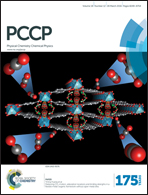Photochemical fabrication of 3D hierarchical Mn3O4/H-TiO2 composite films with excellent electrochemical capacitance performance†
Abstract
We herein report a novel, energy-saving and environmentally benign photodeposition approach to fabricate a manganese oxide film on hydrogenated TiO2 (H-TiO2) nanotube arrays using a Mn2+-containing solution as a precursor. Mn2+ ions are oxidized to Mn3O4 by the photogenerated holes during the photodeposition. The preferential growth of Mn3O4 on the nucleation sites leads to the formation of Mn3O4 nanorods on each H-TiO2 nanotube, forming a 3D hierarchical Mn3O4/H-TiO2 composite film. The as-fabricated 3D hierarchical Mn3O4/H-TiO2 composite film electrode delivers a high specific capacitance of 508 F g−1 at a current of 0.7 A g−1. The composite film electrode still shows a specific capacitance of 228 F g−1 even at a high rate of 35.7 A g−1, demonstrating its prominent rate capability. Remarkably, the composite film electrode shows no obvious capacitance decay after 10 000 charge/discharge cycles at a current density of 3.6 A g−1, revealing its superior electrochemical cycling stability. The prominent pseudocapacitive performance of the composite film electrode can be attributed to its unique structure characteristics. The as-constructed energy-saving and environmentally benign photodeposition method can be used as a general and efficient route to prepare other composite materials with controlled morphologies and dimensions.


 Please wait while we load your content...
Please wait while we load your content...